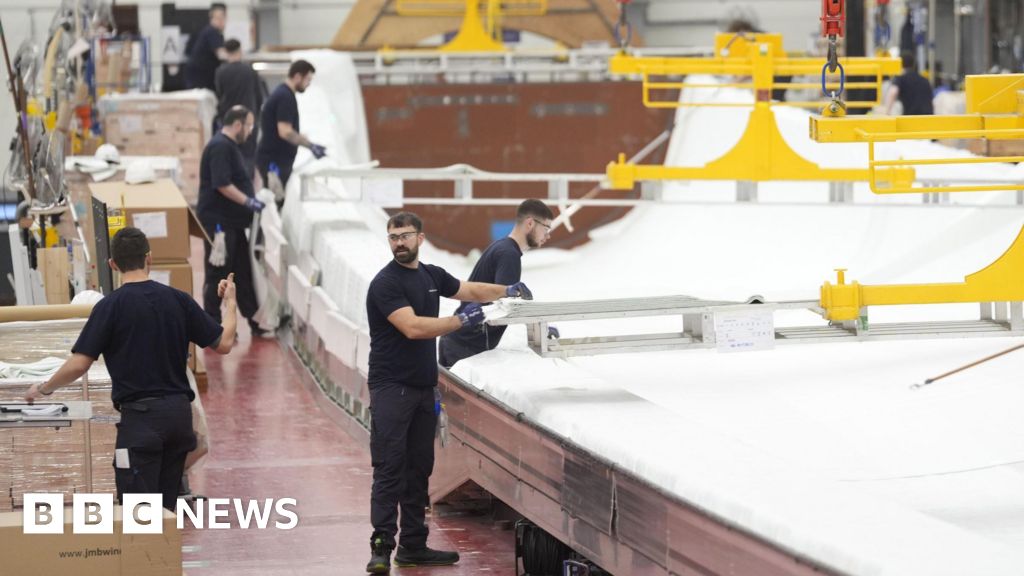Tech
Splunk.conf: Splunk and Cisco showcase unified platform | Computer Weekly

Having spent the best part of a year and a half working to unify its products and tools with those of its new owners Cisco, Splunk is using its annual Splunk.conf event in Boston, Massachusetts, to showcase a number of future developments, beginning with the introduction of the new Cisco Data Fabric platform.
Following the closure of the multibillion dollar purchase in 2024, Splunk and Cisco moved quickly to start to integrate their technology offerings. By last September, as Computer Weekly reported at the time, the duo already had multiple tools, such as Splunk’s Observability Cloud, working well with Cisco AppDynamics, Talos Threat Intelligence and ThousandEyes, and were eyeing closer integration in other areas.
Speaking to reporters in advance of the show’s opening keynote on Monday 8 September, Splunk senior vice president and general manager for EMEA, Petra Jenner, reflected on a busy year and said there were a lot of positive aspects to the deal.
“While we still have our own identity we are working more closely together to achieve better customer experiences,” she said. “One of the key priorities for us is to ensure that customers are really supportive. They see that we are collaborating from a technical point of view.”
Jenner said that prior to Splunk’s acquisition by Cisco, while it had had a strong and growing presence in markets such as the UK, France and Germany, there had been a recognition that it needed to invest in growth.
Cisco’s money has been a catalyst for this investment, not only in the UK but also helping open up more business in countries such as Saudi Arabia and the United Arab Emirates (UAE), said Jenner.
“The impact the acquisition had for the Splunk EMEA team has been extremely good. We have joint customer engagements and there are core initiatives going on so that customers can really leverage the joint Splunk and Cisco, not only the product but also the overall convergence,” said Jenner.
“It also suits very well the technology trends [that are] happening,” she added. “In regard to AI the platform approach is getting more important.”
Jenner also reaffirmed Splunk’s commitment to its IT channel partners both in the security and observability fields, saying it has doubled the numbers on its books. She added that drawing on the strength of Cisco partners – with all the myriad possible networking certifications available – that may not have previously considered Splunk, may help make the platform concept an easier sell to customers looking to do more.
Data Fabric turns machine data into actionable intel
Splunk.conf kicked off on Monday evening with the launch of Cisco Data Fabric, which promises to “transform machine data into AI-ready actionable intelligence”.
On the basis that AI has led to a surge in machine data, but that said data is still largely siloed, fragmented, and hardly ever used, Splunk said Cisco Data Fabric to enable customers to make better decisions, reduce their operational risk, and innovate around AI, for example by helping train custom models, powering agentic workflows, or correlating various streams of machine and business data.
Among some of Data Fabric’s features are the Time Series Foundation Model, which will power pattern analysis and temporal reasoning on time series data to enable anomaly detection, forecasting and root cause analysis, driving proactive operations and easing incident response.
Meanwhile, Cisco AI Canvas, also integrating with Splunk Cloud Platform, will provide an AI agent to orchestrate analysis workflows and workspaces for team collaboration. Splunk described this as a “virtual war room experience” that will let teams glean more in-depth insight, work together in real-time, and make decisions better.
These capabilities will be coming on stream over the next few months, with a few slated for 2026.
Kamal Hathi, Splunk senior vice president and general manager of Splunk, said machine data was now the heartbeat of digital organisations and characterised Splunk as a “heart rate monitor”.
“Our goal is to give customers the fastest, most secure path from data to action,” said Hathi.
“By embedding AI across the platform and embracing open standards, we’re not just helping organisations analyze information faster – we’re enabling them to anticipate change, scale innovation without unnecessary complexity, and deliver digital services that are more resilient, adaptive, and responsive to the needs of their users.”
IDC senior research director of cloud data management, Archana Venkatraman, said Data Fabric addressed a critical pain point – the need to quickly and safely unify vast streams of machine data in the service of resilience.
“By enabling a federated approach that eliminates data movement, it provides a pragmatic solution for organisations operationalising AI at scale,” she said.
“Its focus on real-time search, coupled with a repository for AI-ready data, provides tangible value by reducing complexity and time to insights. This unified architecture is a strong step toward helping customers build more resilient and trustworthy AI systems.”
Searching for Snowflakes
Also on the docket is the launch of Splunk Federated Search for Snowflake, a new platform integration empowering users to connect, query and combine operational and business data across Splunk and Snowflake environments.
Some of its key capabilities include unlimited onboarding of Snowflake data in Splunk; federated queries whereby users can write SPL-like queries to search Snowflake data direct from Splunk; next-gen federation capabilities to combine datasets for more impactful context and insight; and more efficient querying, letting users leverage Snowflake analytics for partial queries before performing final data joins in Splunk.
These capabilities, and others, are slated for a July 2026 release.
Tech
After OpenAI’s new ‘buy it in ChatGPT’ trial, how soon will AI be online shopping for us?

Buying and selling online with e-commerce is old news. We’re entering the age of A-commerce, where artificial intelligence (AI) is increasingly able to shop for us.
At the end of September, OpenAI launched its “Buy it in ChatGPT” trial in the United States, using AI agents built to interact with us to do more of people’s browsing and shopping. The technology is known as “agentic commerce,” sometimes shortened to A-commerce.
American shoppers can now ask for shopping suggestions from US Etsy sellers within a ChatGPT chat—then buy a product immediately, without having to navigate away to look at individual shop pages.
Looking ahead, big companies are now spruiking the next phase of “autonomous A-commerce,” which experts predict could see AI checking out for some shoppers within the next few years.
But is handing over more of our shopping decisions to AI a good thing for us as shoppers, for most businesses or for the planet?
What’s possible right now?
For most people using AI to help them shop, the AI agent is still mostly just searching and recommending products. It still has to shift the customer to the retailer’s website to complete the checkout.
For instance, AI can do most steps to order a pizza—though sometimes slower than doing it yourself—apart from paying at the end.
That’s when we step in: we still need to sign in if we’re part of a loyalty program, enter our personal and delivery details, then finally pay.
With the “Buy it in ChatGPT” trial now underway in the US, the customer never leaves the chat, where the checkout is completed.
Shopify has said more than 1 million of its merchants will soon be able to check out within ChatGPT too. Major US retailer Walmart has similar plans.
What’s next?
In May 2025, Google launched “AI mode shopping.” Some features, like using a full body photo of yourself to virtually “try-on” clothes, are still only available for US shoppers, with limited brands.
At the time, Google said its next step will be a new “agentic checkout […] in coming months” for products sold in the US. It would give shoppers the option of tracking a product until its price drops to within a set budget—then automatically prompting them to buy it, using Google Pay. That checkout option is yet to launch.
Credit card giants Visa and Mastercard are also working on ways to make it easier for AI agents to shop for us.
Both the current and coming forms of A-commerce have the potential to spread fast worldwide, because they run largely on the same global digital infrastructure powering today’s e-commerce: identity, payments, data and compliance.
Consultants McKinsey forecast: “We’re entering an era where AI agents won’t just assist—they’ll decide.”
What are the risks and benefits?
Overspending is a big risk.
A-commerce removes many steps of the shopping journey found in e-commerce or physical commerce, leading to fewer abandoned carts and potentially higher spending.
People would need to trust AI systems with their private data and preferences, and ensure they’re not misused. Permitting AI to shop on your behalf means you are responsible for the purchase and can’t easily demand a refund.
AI systems might focus on price or speed, but not always for what you value most: from how sustainable a product is, to the ethics of how it was made.
Fraud could be a real issue. Scammers could set up AI storefronts to trick the AI, collect the money and never deliver.
Banks will need to figure out how to spot fraud, process refunds, and manage consent when it’s not a person pressing “buy,” but an algorithm doing it on their behalf.
Regulators will need to consider A-commerce in their competition, privacy, data, and consumer protection rules.
A-commerce could offer some limited environmental benefits compared to today’s way of shopping, such as fewer missed deliveries—if you’re happy to share your calendar so your AI agent knows your availability.
But greater consumption would also mean greater environmental impacts: from AI’s voracious energy and water use, to the damage done by fast fashion, more deliveries and indirect pollution.
Changing how we shop and do business
If you have even a small business, the way you make your products and services discoverable online will have to change.
Instead of just having websites built for customers and search engines, all businesses will need to build AI accessible online stores. Those will not look like the websites we see today. It will be more like a data-soaked digital catalog, filled with everything an AI agent needs to place orders: product specifications, price, stock, ratings, reviews, through to delivery options.
All those years of bigger brands buying attention and dominating search results might start to matter less, if you’re able to build a good AI accessible online store. It could be a quiet but massive shift in how trade works.
However, each business’s visibility will depend on how AI systems read and rank sellers. If a business’s data isn’t formatted for AI, it may disappear from view. That could give larger players an edge and once again make it harder for smaller businesses to compete.
How much are we happy to delegate our shopping to AI agents? Our individual and collective choices over the next few years will shape how radically shopping is about to change for years to come.
This article is republished from The Conversation under a Creative Commons license. Read the original article.![]()
Citation:
After OpenAI’s new ‘buy it in ChatGPT’ trial, how soon will AI be online shopping for us? (2025, October 25)
retrieved 25 October 2025
from https://techxplore.com/news/2025-10-openai-buy-chatgpt-trial-ai.html
This document is subject to copyright. Apart from any fair dealing for the purpose of private study or research, no
part may be reproduced without the written permission. The content is provided for information purposes only.
Tech
Why electricity costs so much in the UK (it’s not all about the weather)

The UK government is reportedly considering abandoning its goal of removing fossil fuels from the country’s electricity supply by 2030 in an attempt to keep energy bills down.
This is understandable given that the UK is already one of the most expensive places in Europe to use electricity, something that—despite plenty of investment in relatively cheap renewable energy—is unlikely to change any time soon. In fact, bills remain high even when wind farms are spinning at full capacity.
However, neither a drive to decarbonize the grid—which is needed for other reasons—nor abandoning this target is going to make energy significantly cheaper. The reason for this lies in how electricity markets work, and in the geography and policies that shape the UK’s energy system.
To begin with, wholesale electricity prices are determined in a way that essentially means that everyone has to pay for the most expensive source of electricity used at a given time, which in the UK is mostly gas power plants.
The gas which is burned to power the UK’s lights and kettles has to be liquefied, shipped from the US or Qatar amid global bidding wars, and then converted back into its original state. High gas prices drive high wholesale prices, which directly translate into high electricity bills.
Cheaper renewable energy sources (the cost of producing solar, wind or nuclear electricity is very low) have little effect. This is partly because while the operating cost of renewable electricity is very low, the cost of setting it up is not.
To encourage companies to build new generation capacity, the government must offer them a guaranteed price for the electricity they produce, to compensate for their costs. For a wind farm, this would include money for planning applications, as well as buying and installing turbines and electrical equipment.
Bringing different sources of electricity to consumers also requires expensive infrastructure investment. In the UK, for example, grid capacity is not where it needs to be after decades of low investment.
Nearly 40% of the electricity produced by Scottish wind farms has been wasted so far this year, because the grid was not able to move it to other parts of the UK or store it.
Overall then, consumers’ bills will be high, both now and in the future, because of the combined costs of imported gas, infrastructure and the guaranteed prices for producers.
Most calls to decrease these bills effectively come down to suggesting moving some of these costs on to taxpayers—so effectively from one bill to another. This is what happened in France, where “cheap” nuclear electricity is the result of vast amounts of government spending in the past. The French may not see UK-level energy bills, but they do have higher taxes and public debt.
Clouds on the horizon
Despite these challenges, successive UK governments have committed to continuing investment in new technologies, because dependence on imported, polluting and volatile fossil fuels is deemed too risky. Postponing the full transition to renewables, as reported in the Guardian, is effectively a bet that gas prices will decrease in the short term, and that the UK will be able to commission cheaper renewables later on.
But cheaper renewables present their own problems, because they play different roles. Solar and wind are cheaper, but intermittent. Nuclear is the most expensive but works all the time.
This all presents a challenging situation for UK consumers. New nuclear faces very long safety and planning procedures and the national grid needs to be modernized. The decision to cancel an ambitious project to get solar electricity from Morocco may be regretted.
But the main factor is simply geography and timing. Partly due to its location, the UK has become a world leader in wind power, a renewable technology that seems to be taking a less important global role than solar. And while the cost of solar production is decreasing steeply, the learning curve is slower for wind.
And there is no obvious way to increase the number of sunny hours in England. A country like Spain, with both a lot of sun and wind, has a much easier job transitioning to cheap renewables than the UK.
So, for all the frustration over high bills, the UK’s options are limited. Geography gives us wind, not sunshine. Policy has delivered world-class renewables, but also a grid struggling to carry their power.
The future will depend on whether new technologies, including cheaper batteries, tidal power and small modular nuclear reactors can fill the gaps left by weather and planning delays.
None of this will be easy or cheap. But the alternative—continued dependence on imported, volatile fossil fuels that make bills hostage to global crises—is worse.
UK consumers face a future where electricity remains more expensive than much of Europe, not only because of policy choices, but because it lacks the sunshine that’s driving costs down elsewhere. Betting on emerging technologies is the only way to close that gap.
This article is republished from The Conversation under a Creative Commons license. Read the original article.![]()
Citation:
Why electricity costs so much in the UK (it’s not all about the weather) (2025, October 25)
retrieved 25 October 2025
from https://techxplore.com/news/2025-10-electricity-uk-weather.html
This document is subject to copyright. Apart from any fair dealing for the purpose of private study or research, no
part may be reproduced without the written permission. The content is provided for information purposes only.
Tech
Dealing With Hearing Loss? These Over-the-Counter Hearing Aids Could Help

If you’re spending hundreds or thousands of dollars buying an OTC hearing aid, make sure you’re getting a product that offers a sustainable long-term solution to your hearing loss needs. Aside from the obvious things like sound quality, take a few minutes to look into these specs.
What size and style works best for you? Most hearing aids on the market are classified as either behind-the-ear (BTE) or in-the-ear (ITE). BTE hearing aids are probably what you think of when you picture a hearing aid, consisting of a plastic case that contains the electronics, a thin cable that goes over the ear and inside the canal, and a tiny speaker known as a “receiver,” which sends boosted audio from a person’s surroundings into their ear. By contrast, ITE models are self-contained units that look like a standard pair of wireless earbuds. In-the-ear hearing aids are popular for their incognito aesthetic, and they tend to be a lot easier to pop in and out than their behind-the-ear counterparts. Still, contemporary BTE hearing aids are significantly smaller than the ones “back in the day.” It just comes down to what fits you most comfortably.
Replaceable or rechargeable batteries? Much like wireless earbuds, most OTC hearing aids are equipped with rechargeable batteries and (usually) a portable charging case for easy transport. If you take the case’s battery life into account, you’ll find most OTC models last about a week before you need to connect to a power source. Without the case, rechargeable hearing aids offer anywhere from 10 to 24 hours of battery life per charge (but this goes down by a few hours if you’re using them to stream via Bluetooth). Replaceable batteries, such as those found on the Sony CRE-C10, can last for 70 hours or more before the battery dies. Sounds great, but it means having spares on hand and wrestling with tiny cells, which can be difficult for people with dexterity problems.
Are you comfortable making adjustments? While prescription hearing aids are fitted in-office by a licensed hearing care specialist, OTC devices are self-fitting. In most cases, OTC hearing aid users are expected to be able to tune the devices to their ears, usually with the help of a smartphone app. It’s certainly nice to make your own adjustments on the fly, but it may cost you in the way of personalized care.
What’s the company’s customer support like? If only you could count on quality support from every hearing aid manufacturer! Unfortunately, OTC hearing aid companies are just that—companies. There’s no “standard” for customer service in the industry. Companies like Jabra offer patients comprehensive support, but other brands may leave you on your own.
Is there a trial run? If you’re not happy with your hearing aids, you’ll probably want to have the option to return them without writing all that money off as a sunk cost. Most states require manufacturers to provide patients with a minimum trial period, but I recommend playing it safe by seeking out this info before buying.
What about warranties? Equally important to a reasonable trial period is the inclusion of a comprehensive manufacturer’s warranty. Most brands cover manufacturing defects for up to a year, but it goes without saying that the longer the coverage period, the better the deal. No matter which OTC hearing aid you end up with, make sure the warranty covers loss, damage, and wear and tear.
-

 Tech7 days ago
Tech7 days agoHow to Protect Yourself Against Getting Locked Out of Your Cloud Accounts
-

 Business7 days ago
Business7 days agoGovernment vows to create 400,000 jobs in clean energy sector
-

 Tech7 days ago
Tech7 days agoThe DeltaForce 65 Brings Das Keyboard Into the Modern Keyboard Era—for Better or Worse
-

 Sports1 week ago
Sports1 week agoPCB confirms Tri-nation T20 series to go ahead despite Afghanistan’s withdrawal – SUCH TV
-

 Tech1 week ago
Tech1 week agoThe Best Part of Audien’s Atom X Hearing Aids Is the Helpful, High-Tech Case
-

 Tech1 week ago
Tech1 week agoI Tested Over 40 Heat Protectant Sprays to Find the Best of the Best
-

 Business7 days ago
Business7 days agoDiwali 2025: Gold & silver likely to consolidate next week; Here’s what analysts said – The Times of India
-

 Tech1 week ago
Tech1 week agoSome major Australian towns still have poor phone reception—it’s threatening public safety






